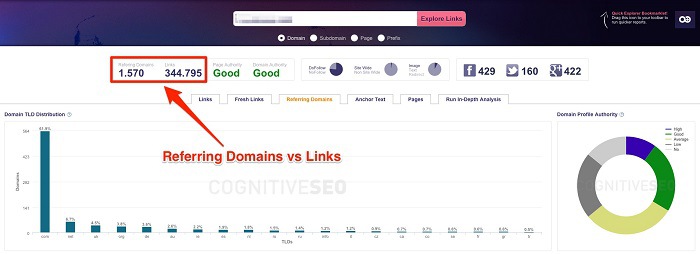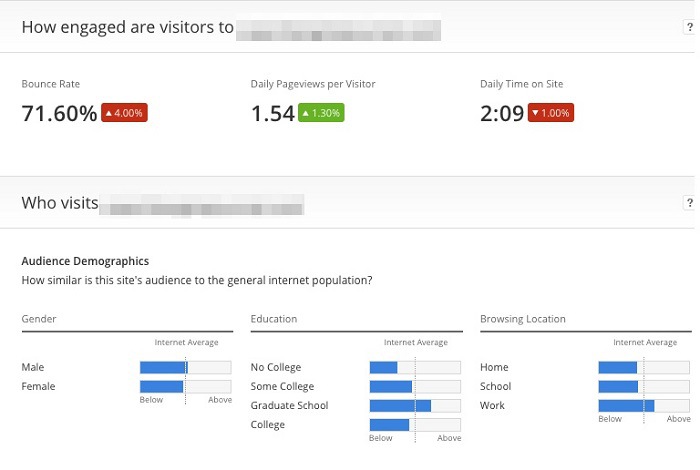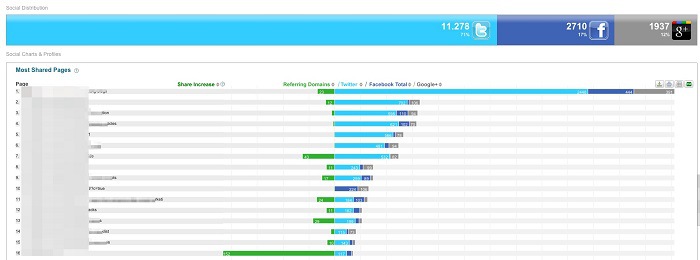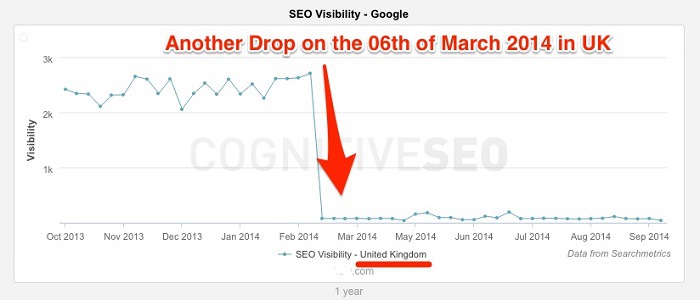To most webmasters, their site is like their baby. It’s the most beautiful and perfect thing in the whole wide world. The fact is, people get too attached to their site and can’t see ways to improve. But as Google gets harsher and swifter with their penalties, you should think of assessing the quality and value of your site. Web owners shouldn’t wait for a penalty to begin assessing their websites. Lacking a complete analysis could leave you one step behind competitors who are proactive and not reactive.
In this article, I will presented a series of site metrics that you should consider when making an in-depth analysis of any site. A good site analysis lays a strong foundation for a good business and might be a good start for finding strategies that will boost the organic rankings of any business.
If you are looking to assess your site, it is like in any other situation in your life: you shouldn’t wait until you stumble upon a problem. You should prevent issues by thinking ahead and finding the strengths and weaknesses of your site. This way, you’ll be able to prevent problems. You may want to assess your site in order to:
- Identify its perceived value
- Spy on a competitor
- Identify flaws and weaknesses
- Find possible opportunities.
There are many other reasons you may want to consider an assessment of your site. We’ve just named a few. You need to constantly ask yourself questions. How well is your site performing? Is your site visible ? Is your website working properly? Are you using your data properly? You need to ask yourself these questions in order to make sure your website is working as well as possible.
The Metrics
To properly asses the value, growth, and quality of any site you need to know which type of metrics you should focus on. Here is a list of some of the most important metrics:
Number of Referring Domains
There’s a lot of information gathered from the referring domains pointing to a website. Google may raise red flags if it notices a very large number of links coming from a very small number of referring domains, as it could be considered a link network. Even though a website has a large number of links, should they be from low authority website, Google may start to question the way in which they were gathered. Remember that shady link building strategies are punished by search engines nowadays.
[pullquote]Webmasters should keep an eye out for a healthy distribution of referring domains to links. Focus on gaining respect from high authority websites as their mentions are of a greater value.[/pullquote]
Let me explain the difference between links and referring domains. Think about referring domains as people who vouch for you, and backlinks as the number of times they say your name. You may have a big number of regular Joes speaking about you constantly, that’s great, you will rank well. But, if you have one mention from a more important person, let’s say a Mick Jagger, this could propel you to the top of the SERPs. Too many backlinks from few domains could be seen as noise or spam and may lead to a dreaded penalty.
Let’s take an example:
 Screenshot taken 01/22/2015 of http://explorer.cognitiveseo.com/
Screenshot taken 01/22/2015 of http://explorer.cognitiveseo.com/As you can see from the chart above, you’ve got a lot of data to work with. The first thing to focus on is what’s being highlighted above; you have a great distribution with a lot of referring domains and a huge number of links. The second is the pie chart which displays the authority of the links for the website. The chart in our example shows a healthy distribution with many good and high authority links. The TLD (Top Level Domain) Distribution chart can show you where the website’s audience is and explains why this is important. If the target is worldwide, the website may want to have a large number of .com domains linking back. But if the target is local, from Spain for example, the goal is to get many links from .es domains.
[pullquote]Be aware of damaging potential from having a large number of links from few domains, as they could trigger red flags with Google.[/pullquote]
What is essential to understand from when studying this metric is that backlinks are not all that important, the most important thing is the number of referring domains linking back to you, the authority of these domains, and the correct audience that speaks about you.
Link Velocity
Providing a clear view of the link building strategies, the Link Velocity chart is one of the most important metric for you to study. Noticing patterns in the link velocity chart might give you some insights regarding the effectiveness of a website’s content strategy. If you compare the spikes to the social visibility chart (detailed below), you could notice if their content strategy works well, and if you see a huge spike with no apparent reason, it could indicate black hat techniques.
The idea behind the link velocity chart is a simple one. It’s basically the number of links a website gathers over a certain period of time. Let’s take an example to see how one could study and draw conclusions from a link velocity chart:
 Screenshot taken 01/22/2015 of http://explorer.cognitiveseo.com/
Screenshot taken 01/22/2015 of http://explorer.cognitiveseo.com/As chart above states, it shows all the links gathered for the website since the existence of time. There is a consistent number of links gathered from May 2011 until January 2013 when the first significant spike appears. A second significant spike appears in July 2014. The next step is to look at what happened on the website during those spikes. After researching the website a bit, we found out that two very successful articles were published in those periods which gained those backlinks.
When studying the link velocity, the most important thing to be aware of is spikes, as they could raise red flags with Google and may lead to a potential penalty. Always remember that gaining good quality, natural backlinks is a task that takes up a lot of time and effort, and your link velocity will show this as well.
Alexa Traffic Growth
Roughly stated, the data gathered from Alexa provides you with an estimate measure of a website’s rank, compared with others from the internet. It’s a great tool and learning how to read Alexa Traffic Growth charts will help you establish which sites are the best in a market, be it local or even global. You will also be able to study the audience and their behavior.
[pullquote]It’s important to keep in mind that the Alexa Traffic tool can sometimes be way off in its results, as it gathers data only from the users using the Alexa toolbar. That is why you always need to check multiple sites in the same niche.[/pullquote]
Alexa works by taking into consideration data regarding the number of visits and the number of pages accessed during a visit. The rank is generated by tracking the traffic data provided by the users using Alexa data panel and is based upon a combined measure of Unique Visitors and Pageviews. This tool gathers traffic data from millions of users across the world. It’s basically a huge chart that gives you insights on how any website is performing by calculating its popularity.
Let’s take this example and try to gain as much information from it:
 Screenshot taken 01/22/2015 of http://www.alexa.com/siteinfo/cognitiveseo.com
Screenshot taken 01/22/2015 of http://www.alexa.com/siteinfo/cognitiveseo.comThe lower the number on the Alexa Chart, the better. The website for this example ranks 2075 worldwide and 3729 in US. A great number for a small business, if the focus is on the US market. The trend for this website is looking good, dropping since August, and may lead to a much better rank in the future.
Let’s get to the audience behavior where we see a 71.6% bounce rate which tells us a lot of the visitors are bouncing back. We have encouraging numbers for the pageviews and the time spent by users on the website. It is advised to take a look at how the competition is doing in order to have an overall image of the market trend.
 Screenshot taken 01/22/2015 of http://www.alexa.com/siteinfo/cognitiveseo.com
Screenshot taken 01/22/2015 of http://www.alexa.com/siteinfo/cognitiveseo.comUsing the Alexa Traffic KPIs comes in real help when trying to go deeper with the audience research or trying to gain precious information on who to address in content strategies. Based on the information from this chart, it’s easier to construct the correct persona of who reads and visits a website on a regular basis. From the example taken, the persona would be a working male with high level of education.
Another great way to use the Alexa Traffic Ranks chart is to compare fluctuations in the traffic and try to correlate the data with the market trends. You can study any niche and get a great view of how well websites rank.
Social Visibility
This is metric uncovers the best content and social media strategies and shows which social media platform work for which niche. It becomes an even more powerful metric if you learn to compare and find correlations between social shares and the Alexa traffic growth charts. You will be able to tell exactly how an audience reacts to certain content strategies and on which social platform the audience is most engaged.
The Social Visibility simply is the total number of shares from all the pages on a site. The most important shares to be considered are from Facebook, Twitter, and Google Plus. Let’s take an example to see how charts should be read:
 Screenshot taken 01/22/2015 of http://tools.cognitiveseo.com/
Screenshot taken 01/22/2015 of http://tools.cognitiveseo.com/From the chart above we can see that the website analyzed has certainly been active on social media platforms. A number of 15,000 shares could be a great number; yet, it should be correlated to the market and the competitors before drawing any conclusion. The distribution on the social media platform is more or less equal, Google plus losing some ground to Facebook or Twitter. Let’s look deeper to see if we can tell which content generates the most activity.
In the screenshot above, you can see which articles gathered the most shares on social platforms. We can also tell which types of articles work better on a certain platforms, and should someone try to tackle that platform, they can tailor their content to suit the audience.
SEO Visibility
With the SEO Visibility metric you have three major benefits to look forward to: you can compare competitors in any market you wish, identify if a website has been struck by a Google penalty, and you can use it as a great pitching tool. Searchmetrics provides a reliable tool to study the SEO Visibility of almost any site by crawling millions of keywords on a weekly basis.
The SEO visibility has two components: the search volume and the position of the ranking keyword. Simply put, it shows how often a site is displayed in the SERPs for a certain keyword. The SEO Visibility metric shows you the value of the market environment and helps to identify market trends and digital marketing strategies. The SEO Visibility is calculated based on millions of keywords that are tracked in Google and their importance and traffic volume. Each keyword has a particular importance and based on that and the ranking of the tracked site, a SEO visibility score is calculated. The score is updated weekly.
Lets take an example and see how we can benefit from studying the SEO Visibility of any website:
 Screenshot taken 01/22/2015 of http://tools.cognitiveseo.com/
Screenshot taken 01/22/2015 of http://tools.cognitiveseo.com/At a quick glance, we can tell the SEO Visibility score of the website, how many keywords provide search engine results and how many keywords rank in top 10 in Google. Having the keyword rankings in a chart, displaying the position and the cost per click of the keyword, it can be concluded what this webmaster is targeting its contents to.
[pullquote]Keeping track of how keywords rank in different countries can be really helpful for your business.[/pullquote]
You can use the SEO Visibility chart to see how a website ranks on different keywords based on the value of the keyword, making it easier for you to target keywords with Adwords that have the best ROI.
Let’s take a look at the next chart:
 Screenshot taken 01/22/2015 of http://tools.cognitiveseo.com/
Screenshot taken 01/22/2015 of http://tools.cognitiveseo.com/Reading this chart, you will immediately noticing any sudden drops. Google penalties are easy to spot and identifying them early can help webmasters take quick action for recovering from it. The same chart can be used to pitch new clients or make the existent ones aware of the necessity for SEO actions.
History of The Site
No full assessment of a website is complete without taking a look at the past of the website. You will be able to notice any significant changes regarding the content or even topics. You might want to know if the website was about cooking lessons and is now selling watches. Also, you might want to know who owned the website and what the owner did with it.
[pullquote]By studying the history of the site you’ll even be able to spy on any website’s actions, check their past prices, and their marketing strategies.[/pullquote]
To learn about the history of the website, there are two great tools. The first one is Wayback Machine, a site which shows snippets of any website since it’s creation. The second tool is whois.is, a site which registers any action taken on the domain level, including if it was sold and by who.
 Screenshot taken 01/12/2015 of web.archive.org
Screenshot taken 01/12/2015 of web.archive.orgWhen you buy a domain you may want to study its history a bit, including the main topics of that domain. The snapshots provided by Wayback Machine are priceless in this case. In addition, by looking back you will be able to learn what prices and which marketing strategies the competitor used at certain points.
 Screenshot taken 01/22/2015 of https://who.is/whois
Screenshot taken 01/22/2015 of https://who.is/whoisYou should definitely be looking into past owners. Having multiple owners usually means there are old links pointing back to it and those links could do some harm to your link profile. Looking at the example above, we can clearly see that the domain changed owners in 2007. More details can be gathered by studying each one of the owners, but it’s your choice how much you want to dig in.
Conclusion
Whether you want to research a niche, study competitors, or improve your own website, the metrics and tools listed will help you get started. Tracking these metrics constantly will give you valuable insight on the evolution of a site, including its current status and the direction it’s heading.
[pullquote]Learning how to compare the different metrics and correlate the data found will make you a force to be reckoned with in any market you wish to tackle.[/pullquote]
You’ll know what weaknesses and strengths the competitors have, the content strategies that work great for the audience, and the target’s behavior to any marketing strategy applied.
What other metrics do you take into consideration when assessing the value and quality of your website?





![AI Overviews: We Reverse-Engineered Them So You Don't Have To [+ What You Need To Do Next]](https://www.searchenginejournal.com/wp-content/uploads/2025/04/sidebar1x-455.png)